| 1 |
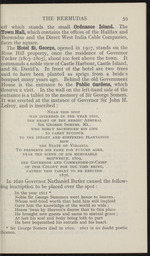 |
“...commands a noble view of Castle Harbour, Castle Island,
and St. David’s. In front of the hotel are two trees
said to have been planted as sprigs from a bride’s
bouquet many years ago. Behind the old Government
House is the entrance to the Public Gardens, which
deserve a visit. In the wall on the left-hand side of the
entrance is a tablet to the memory of Sir George Somers.
It was erectéd at the instance of Governor Sir John H.
Lefroy, and is inscribed :
Near this spot
WAS INTERRED IN THE YEAR l6lO,
THE HEART OF THE HEROIC ADMIRAL
Sir George Somers, Kt.,
WHO NOBLY SACRIFICED HIS LIFE
TO CARRY SUCCOUR
TO THE INFANT AND SUFFERING PLANTATION
NOW
the State of Virginia.
To preserve his fame for future ages,
NEAR THE SCENE OF HIS MEMORABLE
SHIPWRECK, 1609,
the Governor and Commander-in-Chief
of this Colony for the time being,
CAUSED THIS TABLET TO BE ERECTED
1876.
! In 1620 Governor Nathaniel Butler caused the follow-
ing inscription to be placed over the spot:
In the year 1611 *
Noble Sir George...”
|
|
| 2 |
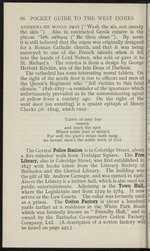 |
“...some interesting mural tablets. On P
the right of the south door is one to officers and men of
the Queen’s Regiment who “ fell victims to this fatal “
climate,” 1816-1817—a reminder of the ignorance which |
unfortunately prevailed as to the communicating agent ^
of yellow fever a century ago. On the right of the F
west door (on entering) is a quaint epitaph of Henry “
Cheeks (ob. 1824), which runs :
Tablet of inky hue ; ï &
remain fe
and mark the spot
Where noble dust is shrin’d
For well the poet’s strain hath sung
An honest man’s the noble work Of God.
The Central Police Station is in Coleridge Street, about ®
a five minutes’ walk from Trafalgar Square. The Free F
Library, also in Coleridge Street, was first established in f
1847 with books taken from the Literary Society, of
Barbados and the Clerical Library. The building was $
the gift of Mr. Andrew Carnegie, and was opened in 1906. ®
Above the Library is a lecture halt, which is also used for D
public entertainments. Adjoining is the Town...”
|
|
| 3 |
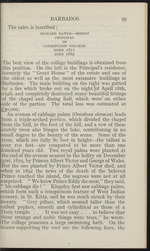 |
“...in 1892 the news of the death of the beloved
Prince reached the island, the negroes were not at all
surprised. " We knew Prince Eddy die soon,” they said,
j his cabbage die ! ” Kingsley first saw cabbage palms,
which form such a conspicuous feature of West Indian
scenery, in St. Kitts, and he was much struck by their
beauty. “ Grey pillars, which seemed taller than the
tallest poplars, smooth and cylindrical as those of a
porie temple. ... It was not easy ... to believe that
these strange and noble things were trees,” he wrote.
[The college possesses a large swimming bath. On the
beams supporting the roof are the following lines, the...”
|
|
| 4 |
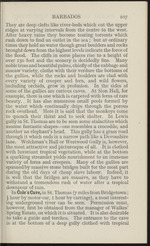 |
“...BARBADOS
107
I They are deep clefts like river-beds which cut the upper
I ridges at varying intervals from the centre to the west.
I After heavy rains they become tearing torrents which
I rush down to find an outlet in the sea; but at ordinary
I times they hold no water though great boulders and rocks
I brought down from the highest levels indicate the force of
I the flood, The cliffs in some places rise to a height of
I over 150 feet and the scenery is decidedly fine. Many
I noble trees and beautiful palms, chiefly of the cabbage and
I macaw variety, clothe with their verdure the bottoms of
I the gullies, while the rocks and boulders are clad with
I every variety of creeper and fern, and wild flowers,
I including orchids, grow in profusion. In the sides of
I some of the gulliës are curious caves. At Sion Hall, for
I example, there is one which is carpeted with ferns of rare
I beauty. It has also numerous small pools formed by
I the water which continually drips through the porous
I rock...”
|
|
| 5 |
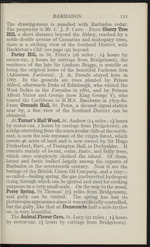 |
“...BARBADOS
in
I The drawing-room is panelled with Barbados cedar.
The proprietor is Mr. C. J. P. Cave. From Cherry Tree
| Hill, a short distance beyond the Abbey, reached by a
I noble double avenue of Casuarina and mahogany trees,
I there is a striking view of the Scotland District, with
I Hackleton’s Cliff (see page 92) beyond.
Farley Hill, in St. Peter’s (16 miles; 1J hours by
I motor-car, 3 hours by carriage from Bridgetown), the
I residence of the late Sir Graham Briggs, is notable as
I being the original home of the beautiful Farliense fern
I (Adiantum Farliense). J. A. Froude stayed here in
I 1887. In the grounds are trees planted by Prince
I Alfred, afterwards Duke of Edinburgh, who visited the
I West Indies in the Euryalus in 1861, and by Princes
I Albert Victor and George (now King George V), who
I toured the Caribbean in H.M.S. Bacchante in 1879-80.
I From Grenade Hall, St. Peter, a disused signal-station
I near by, a fine view of the Scotland District can be
I obtained.
At Turner’s...”
|
|
| 6 |
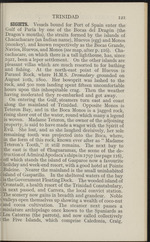 |
“...AdmiralApodaca’s ships in 1797 (seepage 116),
i off which stands the island of Gasparee now a favourite
I holiday and week-end resort, with a good hotel at Pointe
iBaMne. Nearer the mainland is the small uninhabited
I island of Gasparillo. In the sheltered waters of the bay
if is the Government Floating Dock. The wooded island of
(Kronstadt, a health resort of the Trinidad Constabulary,
j| is next passed, and Carrera, the local convict station.
IThe scenery now gains in breadth and grandeur. Noble
■galleys open themselves up showing a wealth of coco-nut
a and cocoa cultivation. The steamer next passes a
llnuniature archipelago once known to the Spaniards as
IjLos Catorras (the parrots), and now called collectively
tithe Five Islands, which comprise Caledonia, Craig,...”
|
|
| 7 |
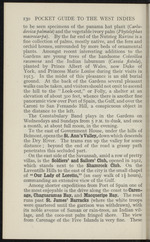 |
“... I
which stands next to the Shamrock Club. On the I
Laventille Hills to the east of the city is the small chapel I
of “Our Lady of Loretto,” (an easy walk of ij hours), I
commanding an extensive view of the Gulf.
Among shorter expeditions from Port of Spain one of j
the most enjoyable is the drive along the coast to Caren- I
age, Chaguaramas Bay, and Macqueripe Bay. The road I
runs past St. James’ Barracks (where the white troops I
were quartered until the garrison was withdrawn), with I
its noble avenue of Saman or rain-trees, an Indian vil- I
lage, and the coco-nut palm fringed shore. The view I
from Carenage of the Five Islands is very fine. These I
-...”
|
|
| 8 |
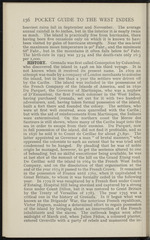 |
“...the Indians
were exterminated. On the northern coast the Mome des
Sauteurs is still shown, where many of the Caribs leapt into the
sea in order to escape from their enemies. Du Parquet, now
in full possession of the island, did not find it profitable, and so
in 1656 he sold it to Count de Cerillac for about ^1,890. The
latter appointed as Governor a man “ of brutal manners,” who
oppressed the colonists to such an extent that he was tried and
condemned to be hanged. By pleading that he was of noble
origin he managed, however, to get the sentence altered to one
of beheading, but no skilful executioner being available, he was
at last shot at the Summit of the hill on the Grand Etang road.
De Cerillac sold the island in 1664 to the French West India
Company, and on the dissolution of that organisation at the
end of the year 1674 it passed to the French Crown. It remained
in the possession of France until 1762, when it capitulated to
Great Britain, to whom it was formally ceded in the following...”
|
|
| 9 |
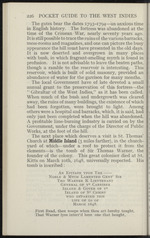 |
“...profitable lime-burning industry is carried on by the
Government, under the charge of the Director of Public
Works, at the foot of the hill.
The next place which deserves a visit is St. Thomas’
Church at Middle Island (3 miles farther), in the church-
yard of which—under a roof to protect it from the
elements—is the tomb of Sir Thomas Warner, the
founder of the colony. This great coloniser died at St.
Kitts on March 10th, 1648, universally respected. His
tomb is inscribed:
An Epitaph vpon The-----
Noble & Mych Lamented Gent’ Sir
Tho Warner K Lievtenant
General of ye Carribee
Ieland & Gover of ye
Ieland of St Christ
who departed this
LIFE OF IO OF
March 1648.
First Read, then weepe when thou art hereby taught,
That Warner lyes interr’d here one that bought....”
|
|
| 10 |
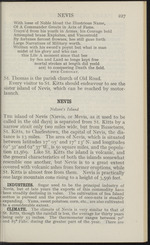 |
“...NEVIS
227
With losse of Noble bloud the Illustrious Name,
Of A Commander Create in Acts of Fame.
Trayn'd from his youth in’Armes, his Courage bold
Attempted braue Exploites, and Vncontrold
By fortunes fiercest frownes, hee still gaue forth
Large Narratiues of Military worth.
Written with his sword’s poynt but what is man
midst of his glory and who can
this Life A moment since that bee
by Sea and Land so longe kept free
mortal strokes at length did yeeld
ace) to conquering Death the field.
FINE CORONAT.
,St. Thomas is the parish church of Old Road.
Every visitor to St. Kitts should endeavour to see the
sister island of Nevis, Which can be reached by motor-
launch.
NEVIS
Nelson’s Island
The island of Nevis (Nievis, or Mevis, as it used to be
called in the old days) is separated from St. Kitts by a
narrow strait only two miles wide, but from Basseterre,
St. Kitts, to Charlestown, the capital of Nevis, the dis-
tance is 13 miles. The area of Nevis, which is situated
I between latitudes 170...”
|
|
| 11 |
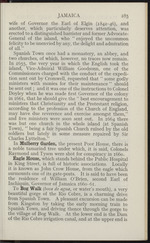 |
“...that he should give the “ best encouragement to
ministers that Christianity and the Protestant religion,
according to the profession of the Church of England,
may have due reverence and exercise amongst them,”
and five ministers were soon sent out. In 1664 there
was but one church in the whole island (at Spanish
Town), “ being a fair Spanish Church ruined by the old
soldiers but lately in some .measure repaired by Sir
Charles Lyttelton.”
In Mulberry Garden, the present Poor House, there is
a noble tamarind tree under which, it is said, Colonels
Raymond and Tyson were shot for conspiracy in 1660.
Eagle House, which stands behind the Public Hospital
in King Street, is full of historic associations. Locally
it is known as John Crow House, from the eagle which
surmounts one of its gate-posts. It is said to have been
the residence of William O’Brien, second Earl of
Inchiquin, Governor of Jamaica 1660-61.
To Bog Walk (boca de agua, or water’s mouth), a very
beautiful gorge of the Rio Cobre, is...”
|
|
| 12 |
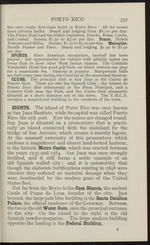 |
“...Bautista, while its capital was called Puerto
Rico, the rich port. Now the names are changed round.
San Juan is situated on a promontory that is practi-
cally an island connected with the mainland by the
bridge of San Antonio, which crosses a marshy lagoon.
At the seaward extremity of this promontory, which
encloses a magnificent and almost land-locked harbour,
is the historic Mono Castle, which was erected between
the years 1539 and 1584. San Juan was once strongly
fortified, and it still forms a noble example of an
old Spanish walled city; and it is noteworthy that
though the elaborate fortifications existing in 1898 were
obsolete they suffered no material damage when they
were bombarded by the modem guns of the United
States fleet.
Not far from the Morro is the Casa Blanca, the ancient
Castle of Ponce de Leon, founder of the city. Just
beyond, the large pale blue building is the Santa Catalina
Palace, the official residence of the Governor. Between
the two is the old Water Gate, once the principal...”
|
|
| 13 |
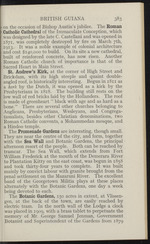 |
“...BRITISH GUIANA
383
on the occasion of Bishop Austin’s jubilee. The Roman
Catholic Cathedral of the Immaculate Conception, which
was designed by the late C. Castellani and was opened in
1871, was completely destroyed by fire on March 7th,
1913. It was a noble example of colonial architecture
and cost $140,000 to build. On its site a new cathedral,
built of reinforced concrete, has now risen. Another
Roman Catholic church of importance is that of the
Sacred Heart in Main Street.
St. Andrew’s Kirk, at the comer of High Street and
Brickdam, with its high steeple and quaint double-
angled roof, is historically interesting. Begun in 1811 as
a kerk by the Dutch, it was opened as a kirk by the
Presbyterians in 1818. The building still rests on the
low wall of red bricks laid by the Hollanders. The roof
is made of greenheart “ black with age and as hard as a
bone.” There are several other churches belonging to
Anglicans, Presbyterians, Wesleyans, and Congrega-
tionalists, besides other Christian...”
|
|
| 14 |
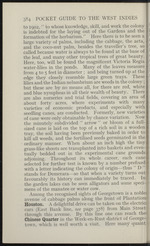 |
“...are transplanted into baskets and even-
tually bedded out in the experimental cane grounds
adjoining. Throughout its whole career, each cane
selected for further test is known by a number prefixed
with a letter indicating the colony of origin—thus “ D ”
stands for Demerara—so that when a variety turns out
favourably its history can immediately be traced. In:
the garden lakes can be seen alligators and some speci-
mens of the manatee or water cow.
Among the recognised sights of Georgetown is a noble
avenue of cabbage palms along the front of Plantation!
Houston. A delightful drive can be taken on the electric |
cars (East Bank line, see page 378) from Main Street
through this avenue. By this line one can reach the
Chinese Quarter in the Werk-en-Rust district of George-:
town, which is. well worth a visit, Here many quaint!...”
|
|
| 15 |
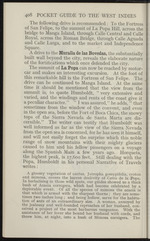 |
“...extensive and
varied, and the windings and rents of the coast give it
a peculiar character,” " I was assured,” he adds, “ that
sometimes from the window of the convent, and even
in the open sea, before the Fort of Boca Chica, the snowy
tops of the Sierra Nevada de Santa Marta are dis-
cernible.” The writer can testify that Humboldt was
well informed as far as the view of the Sierra Nevada
from the open sea is concerned, for he has seen it himself
and will not easily forget the surprise which this noble
range of snow mountains with their mighty glaciers
caused to him and his fellow passengers on a voyage
along the Spanish Main a few years ago. Horqueta,
the highest peak, is 17,600 feet. Still dealing with the
Popa, Humboldt in his personal Narrative of Travels
writes:
A gloomy vegetation of cactus, Jatropha gossypifolia, croton
and mimosa, covers the barren declivity of Cerro de la Popa.
In herbalising in those wild spots, our guides showed us a thick
bush of Acacia cornigera, which had become...”
|
|
| 16 |
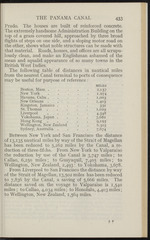 |
“...THE PANAMA CANAL
433
■ Prado. The houses are built of reinforced concrete,
r The extremely handsome Administration Building on the
| top of a grass covered hill, approached by three broad
| flights of steps on one side, and a sloping motor road on
the other, shows what noble structures can be made with
that material. Roads, houses, and offices are all scrupu-
i lously clean, and make an Englishman ashamed of the
mean and squalid appearance of so many towns in the
British West Indies.
The following table of distances in nautical miles
from the nearest Canal terminal to ports of consequence
may be useful for purpose of reference :
Between New York and San Francisco the distance
of 13,135 nautical miles by way of the Strait of Magellan
has been reduced to 5,262 miles by the Canal, a re-
duction of three-fifchs. From New York to Valparaiso
the reduction by use of the Canal is 3,747 miles; to
Callao, 6,250 miles; to Guayaquil, 7,405 miles; to
Wellington, New Zealand, 2,493 : to Yokohama, 3,678...”
|
|
